Do Orthotic Insoles Really Work?

 Guest Author: Dr. Donna Schwontkowski
Guest Author: Dr. Donna Schwontkowski
Do you have flat feet or plantar fasciitis? Have you been thinking about getting orthotic insoles but just don’t know whether they are worth it?
If so, I was just like you until I tried a pair that literally changed my life. I want to tell you my story because if I can help someone’s feet feel better, then it would really change a life.
My feet – maybe like yours – are as flat as a pancake and they have been like this my whole life. I even noticed my feet spread out when I tried on new shoes at the shoe store. No shoes really made my feet feel good.
When activities required long hours of standing, walking, or running, my feet were always my limiting factor. My foot pain would be excruciating afterward, and only long periods of rest would relieve it. If you have flat feet, you most likely understand what this is like.
Having bunions didn’t help either, and only reinforced my fallen arches. My feet resembled duck feet. Although I wasn’t diagnosed with plantar fasciitis, had I not restricted foot activities, I would have easily developed the condition.
What is Plantar Fasciitis?
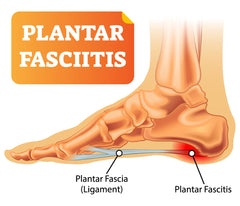 Plantar fasciitis is a condition where the fascia or connective tissue on the bottom of the feet becomes exceptionally tight and inflamed. It causes pain in the bottom of the feet and can be caused by fallen arches. When the part of the fascia on the bottom of the foot that is normally held up by the arch falls, your body weight then puts extra pressure on the fascia. This causes the inflammation.
Plantar fasciitis is a condition where the fascia or connective tissue on the bottom of the feet becomes exceptionally tight and inflamed. It causes pain in the bottom of the feet and can be caused by fallen arches. When the part of the fascia on the bottom of the foot that is normally held up by the arch falls, your body weight then puts extra pressure on the fascia. This causes the inflammation.
Alignment is Equal to Beauty
The worst part about my flat feet was that the pain didn’t stop there. It travelled up to my knees, my left hip, low back and neck. There’s a scientific reason for this, one that I learned while becoming a chiropractor. When your feet are out of order and the arches are collapsing, everything else connected to the skeletal ‘chain’ of bones will also start breaking down. Fallen arches cause the knee to turn inward. This causes wear and tear on the cartilage and tendons of the knee. The gait is altered and the hips have to change their movement pattern. This alters the sacrum, low back and eventually the neck.
I just saw another example of this occur in a friend who twisted her ankle a few months ago. She let it rest for a few weeks as best she could, but then started developing excruciating knee pain. Giving her feet some rest is only part of the answer because it doesn’t address the foot and ankle alignment that was altered by her ankle injury. The body tries to adapt and change the way we walk in situations like this – and in her case, there was a slight alteration in the way her knees and ankles lined up. This caused her knee pain to a level of 6 to 7 on a 0-10 pain scale where 0 is no pain at all and 10 is pain that causes unconsciousness.

Unfortunately, the condition worsened and she became unable to put weight on her legs at all. Her husband had to carry her from room to room around the house. A month later, she was in a wheelchair. By then, her hips and neck were also hurting. She visited me and I saw firsthand how the progression of these symptoms all stemmed from one thing: the misalignment in her ankle and foot.
The root cause could have also been flat feet. The only difference would have been that the development of the additional symptoms such as pain in her joints progressing to other parts of her body in her joints would have taken longer.
What this case shows is that proper alignment is critical to the well being of the entire musculoskeletal system and one of the most important areas of alignment is the feet and knees.
Many people have discovered the beautifying effects and problem-solving abilities of orthotic insoles in their quest for relief from foot pain. However, all insoles are not created equal.
Cushion vs. Support
Some insoles are merely a piece of cushioning made to replace your currently existing insole. This type feels good temporarily, but only because they provide more cushioning than your previous pair. However, this mild cushioning provides no real support and will only provide mild relief from the foot impact.
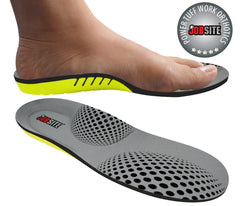 An example of this is that of those who work in the dish room of restaurants. Anti-fatigue mats are placed under their feet in the work area so they can work more productively. These anti-fatigue mats offer more cushioning for the feet than concrete or tile, but all the cushioning in the world still won’t restore a fallen arch to its proper alignment. The problem is that cushioning insoles and anti-fatigue mats are flat, so they apply cushioning evenly across the foot. They do not provide a contoured support for the arch of your foot or a heel cradle that keeps the foot from rolling out of alignment.
An example of this is that of those who work in the dish room of restaurants. Anti-fatigue mats are placed under their feet in the work area so they can work more productively. These anti-fatigue mats offer more cushioning for the feet than concrete or tile, but all the cushioning in the world still won’t restore a fallen arch to its proper alignment. The problem is that cushioning insoles and anti-fatigue mats are flat, so they apply cushioning evenly across the foot. They do not provide a contoured support for the arch of your foot or a heel cradle that keeps the foot from rolling out of alignment.
Your foot pain and other lower extremity pain caused from improper alignment, will not be relieved using these standard cushioning-only types of insoles or mats.
The other type of insole is one designed with proper orthotic support that most feet require. These usually consist of a high arch support and a heel cradle.
A Heel cradle will start your step off right
The heel cradle will keep your heel in proper alignment, preventing it from rolling outward or inward. Since your heel is the first thing to hit the ground in a normal stride, it leads the rest of your foot into a proper or improper step. A heel cradle keeps the heel properly aligned to start your steps off right.
Arch support is key to proper alignment of the whole body
Alignment in the feet requires a good arch support. For those of us who have fallen arches, we have to prop up the arch or we will end up with further alignment problems.
If you have flat feet, an arch support props up your arch to the position where it belongs. This arch support alleviates the stress on your foot muscles from constantly contracting, trying to do the work they can’t possibly do on their own because there’s no natural infrastructure in flat feet.
It’s not fair that our feet never developed good arches, however it’s not uncommon and it is up to us to remedy the situation. Once the arches are in proper alignment, the rest of the bones in the skeleton will line up.
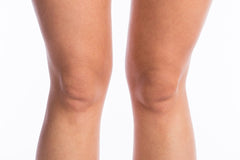 When your feet are properly cushioned for standing and walking for long periods of time– and supported in alignment properly – all limitations on your foot muscles are removed. The muscles can contract and relax easily, as they should. Foot muscles that fatigue will use up a lot of energy, creating a feeling of fatigue. Once you begin to use a product with cushioning and support, you may find long hours on the job do not feel as tiring or painful as before. If the pain recedes in time, you may also avoid some expensive trips to your doctor, chiropractor or massage therapist.
When your feet are properly cushioned for standing and walking for long periods of time– and supported in alignment properly – all limitations on your foot muscles are removed. The muscles can contract and relax easily, as they should. Foot muscles that fatigue will use up a lot of energy, creating a feeling of fatigue. Once you begin to use a product with cushioning and support, you may find long hours on the job do not feel as tiring or painful as before. If the pain recedes in time, you may also avoid some expensive trips to your doctor, chiropractor or massage therapist.
Does Research Support This?
You may be thinking that all this is hearsay but actually there are quite a few different research studies that give us more evidence that orthotic insoles work.
1. Combination Studies Called Metastudies Show Orthotics Work
One study published in the British Journal of Sports Medicine in January 2017 (https://www.ncbi.nlm.nih.gov/pubmed/27919918) looked at how effective shock absorbing insoles (foot orthotics) were to prevent injury. Podiatrists at Australian colleges and universities evaluated 18 different studies to get to the bottom line of truth about them.
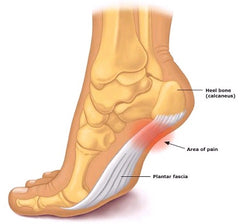 They found that the orthotics with arch supports were effective for preventing injury and stress fractures that come from repetitive trauma (such as running, marching in the military, jumping, stamping on something, jogging, and other activities). The supportive insoles that didn’t have any other features such as arch supports were not effective for preventing injury and stress fractures.
They found that the orthotics with arch supports were effective for preventing injury and stress fractures that come from repetitive trauma (such as running, marching in the military, jumping, stamping on something, jogging, and other activities). The supportive insoles that didn’t have any other features such as arch supports were not effective for preventing injury and stress fractures.
Metastudies such as this look at general trends. What this study is basically saying is that there are two types of insoles that were compared: those with cushioning only and those with cushioning and arch supports.
While this study did not mention flat feet or foot pain in particular, it implies that those who used arch support orthotics (which included cushioning plus alignment of the feet via the arch support) had less pain. These orthotics prevented pain from occurring due to injury and stress fractures from activities that are associated with standing for long periods of time, walking, marching, and jogging.
How this translates to real life is clearly noticeable in people whose occupations include standing for long periods of time, walking, marching or jogging. These activities cause foot pain at the end of a work day because foot muscles fatigue, especially when foot alignment is not proper due to fallen arches.
My conclusions based on study 1
Interpreting this study and making a personal conclusion about whether or not to use insoles is the next step after finding and reading the study. After research into some popular insoles I saw online and in stores, I decided to test the JobSite Power Tuff Orthotic Insoles. They were a good choice for me with my flat feet. As a chiropractor, I walk constantly from room to room with patients. I need strong support and cushion for my feet. These insoles would potentially help prevent stress fractures and injury, two things that could rob me of potential income because of missed work.
These types of orthotic insoles would work for those who have manufacturing jobs, construction jobs, those who are teachers, airline staff, and those in occupations that require a lot of walking.
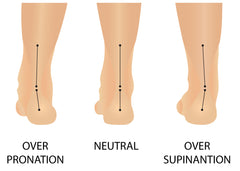 The arch supportive insoles prop up my arch, reduce fatigue in the small muscles of my feet, relieve potential stressors acting on the fascia, and seem to release stress tension in the muscles up my whole spine. When my arch is in the correct anatomical position, my ankles won’t turn inward or outward (conditions known as over-pronation and supination or valgus and varus).
The arch supportive insoles prop up my arch, reduce fatigue in the small muscles of my feet, relieve potential stressors acting on the fascia, and seem to release stress tension in the muscles up my whole spine. When my arch is in the correct anatomical position, my ankles won’t turn inward or outward (conditions known as over-pronation and supination or valgus and varus).
How many times have you walked outside or on the job and suddenly twisted your ankle? This happens more often when you have flat feet because you can more easily misstep. Your ankle is very stable when it’s anatomically correct, but once it gets out of alignment that stability is gone.
Take a look at the different ankle positions in the photo above and you’ll see what I mean. (See how easy it could be to twist your ankle if your heels are placed in the positions other than the center pair of feet?)
Let’s look at the second study.
2. The Boot Camp and Orthotic Insoles Study
This study was also run by podiatrists in Australia and published in the same journal about 15 months later. (https://www.ncbi.nlm.nih.gov/pubmed/29056595)
Participants in the study were three hundred six Navy cadets between the ages of 17 and 50 years, who were going through an 11-week boot camp type of training.
 Boot camps are particularly stressful on the body as many trainees go from minimal activity in their daily lives to intense levels of activity. All this activity in a short period of time counts as repetitive stress and takes a toll on the bones, muscles, ligaments, tendons and fascia of the feet. Approximately half of participants in this study received orthotics with support, while the other half didn’t have any orthotics at all.
Boot camps are particularly stressful on the body as many trainees go from minimal activity in their daily lives to intense levels of activity. All this activity in a short period of time counts as repetitive stress and takes a toll on the bones, muscles, ligaments, tendons and fascia of the feet. Approximately half of participants in this study received orthotics with support, while the other half didn’t have any orthotics at all.
Doctors kept records of those who developed symptoms of plantar fasciitis, heel pain, medial tibial stress syndrome, patellofemoral pain and Achilles tendon pain. By the way, medial tibial stress syndrome could easily occur in someone whose feet are incorrectly anatomically aligned. The same thing would be true for someone with patella (knee bone) femoral (thigh) pain.
Those in the control group who did not wear orthotics in their shoes had 40 injuries (26.1% of the total number of people in the group) while those who wore orthotics had only 27 injuries (17.6%). There were 34% fewer injuries in the orthotic group. The podiatrists concluded that the orthotic insoles with arch supports may be beneficial for reducing the incidence of injury to the lower leg during boot camp training.
Now let’s see if there’s a correlation to my life – or yours.
My conclusions based on study 2
Let’s say I’m going to take on a new job activity that will require a lot of walking and activity on my feet. This could be several days or weeks of working at a trade show booth on concrete floors with a lot of walking, teaching an 11-week course eight hours a day, starting a new exercise plan, or just switching activities and perhaps moving a whole household with plenty of packing over a three to four week period of time.
My own body is not used to this type of activity but from this research I know that I have a lesser chance of injuring myself by wearing orthotic insoles than not wearing them. I’d make a mental note of this and make sure I use supportive insoles in my shoes to help prevent pain and injury that are likely to come from these new activities.
3. Bunions are an Indication of Foot Misalignment
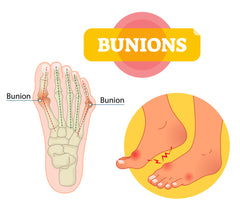 The next study is one I especially like because it tells me that having bunions (like I do) can be helped. Scientists in Iran checked out what would happen to the plantar foot pressures in the middle of the forefoot if someone wore appropriate arch support insoles/orthotics. The women selected for this study had mild to moderate bunion problems and wore the arch support orthotics for 4 weeks.
The next study is one I especially like because it tells me that having bunions (like I do) can be helped. Scientists in Iran checked out what would happen to the plantar foot pressures in the middle of the forefoot if someone wore appropriate arch support insoles/orthotics. The women selected for this study had mild to moderate bunion problems and wore the arch support orthotics for 4 weeks.
The researchers found that the pressure on the big toe joints decreased significantly with the use of the orthotics. The force was distributed to other parts of the foot, thus alleviating and relieving some of the pain that goes with having bunions. (https://www.ncbi.nlm.nih.gov/pubmed/24515981)
My conclusions based on study 3
In the interpretation of this, I can see why my feet felt better wearing the JobSite Power Tuff Orthotic Insoles. With the arch support in the orthotics, which placed my foot bones in proper anatomical position, the joints of the bunion in the big toe were moved ever so slightly, yet correctly, to a better alignment. When this happened, the pressure on the bunion joint was lessened so there was less inflammation, and thus less pain. With less pain and less inflammation, my feet were happy again! And really, who can ever be happy when their feet are not happy?
4. Deep Heel Cups Hold Your Foot In Alignment
Let’s see what the research has to say about deep heel cups added to orthotics.
Researchers at the Department of Rehabilitation at a hospital in Taiwan collaborated efforts with Taiwan University scientists to test out whether or not orthotics could be added to the shoes of older patients to prevent them from suffering from falls (https://www.ncbi.nlm.nih.gov/pubmed/24600215).
It’s quite common for older patients to lose their balance and fall, which often leads to breaking a hip and can literally cost someone their life. Many people never recover from a fractured hip from a fall.
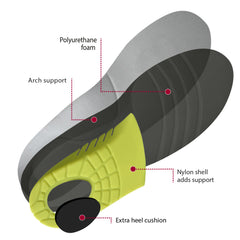 These scientists wanted to design a new insole that would somehow improve the ability of an elderly patient to stand correctly and not wobble and fall. Forty-five patients were enrolled in the study and half of them wore an arch support insole with a deep heel cup for a minimum of four hours each day. The researchers found that the insoles really did make a statistical difference in the elderly’s ability to stand with good stability – and this may benefit them in preventing falls.
These scientists wanted to design a new insole that would somehow improve the ability of an elderly patient to stand correctly and not wobble and fall. Forty-five patients were enrolled in the study and half of them wore an arch support insole with a deep heel cup for a minimum of four hours each day. The researchers found that the insoles really did make a statistical difference in the elderly’s ability to stand with good stability – and this may benefit them in preventing falls.
5. How the Heel Cup Got Added to Orthotics
The heel cup was designed around 1993 to prevent flat feet from becoming a major disability in adults over time. One of the first studies on heel cups was published in the Italian Journal of Orthopedics & Traumatology by Dr. G. Capasso. He tested the heel cups on children affected with the worst symptoms due to serious cases of flat feet. The results were “extremely good” and correction of the flat foot was achieved in a significantly higher number of patients that wore the corrective and supportive insoles with the heel cups than in the control group. (https://www.ncbi.nlm.nih.gov/pubmed/8567249)
My conclusions based on study 4 & 5
If doctors can document great results in children with the worst possible cases of flat feet with orthotics that have a deep heel cup, then using orthotics with a deep heel cup can help my feet, too. This is probably why the JobSite insoles felt so good on my feet!
The JobSite Power Tuff orthotic insoles have a deep, sturdy heel cup. If your feet have a tendency to roll while walking, wearing an insole that secures your heel into a deep heel cup is similar to fitting breasts into a bra that holds them securely: there’s less chance of injury, and more stability and support. The proper alignment for your foot keeps you on track while you’re walking, resulting in fewer sprained ankles and other injuries.
I can think about how often my feet do seem to be unstable, and can remedy the situation with the orthotics. Stability when I walk and stand is always preferable to lack of stability.
Another Thing I Found with the JobSite Power Tuff Orthotic Insoles
 The JobSite Power Tuff Orthotic Insoles have an Aegis Microbe Shield® treatment applied to the top cover of these insoles for the purpose of killing microbes. The microbes on the bottom of our feet cause our feet to smell.
The JobSite Power Tuff Orthotic Insoles have an Aegis Microbe Shield® treatment applied to the top cover of these insoles for the purpose of killing microbes. The microbes on the bottom of our feet cause our feet to smell.
The Aegis Microbe Shield® is particularly interesting in how it was created to kill microbes. It utilizes 3-trimethoxy silyl propyl dimethyl octadecyl ammonium chloride, which contains a silane base that bonds the antimicrobial to any surface.
The nitrogen molecule in the ammonium chloride is positively charged, pulling negatively charged microbes into itself. There’s also a long molecular chain that pierces the cell membrane of all microbes that come into contact with it. The Aegis Microbe Shield® protects your feet from microbes, something that is especially important if you are subject to foot infections including foot fungus.
This treatment cannot rub off onto skin and thus makes it safe to wear even in direct contact with skin, making it a trusted treatment used by many national apparel brands.
I noticed no foot odor with the JobSite Power Tuff Orthotic Insoles. I don’t normally notice a big problem with foot odor but sometimes it appears out of nowhere. Obviously it’s embarrassing when it happens.
Real Benefits from Orthotic Insoles
All the positive things that resulted from me wearing the JobSite Power Tuff Orthotic Insoles make a lot of sense after looking at the studies on orthotics mentioned above.
Here are 7 different benefits I found:
- Foot fatigue disappeared
- Foot pain was gone after a few days
- Bunion pain lessened a lot – about 50%
- Greater foot stability and better posture,
- Less chance of falling and injuries
- Feet smell better
- Happy feet lead to better moods and a better life!

If you are at work all day on your feet and need proper support, get a pair of orthotic insoles. I tried the JobSite Power Tuff Orthotic Insoles and I loved them. I think you will love them too. By the way, you should know that the reason why I chose the JobSite brand based on their great ratings, price, and availability.
Sources:
Bonanno, D.R., et al. Effectiveness of foot orthoses and shock-absorbing insoles for the prevention of injury: a systematic review and meta-analysis. Br J Sports Med 2017 Jan;51(2):86-96.
Bonanno, D.R., et al. Effectiveness of foot orthoses for the prevention of lower limb overuse injuries in naval recruits: a randomized controlled trial. Br J Sports Med 2018 Mar;52(5):298-302.
Farzadi, M., et al. Effect of medial arch support foot orthosis on plantar pressure distribution in females with mild to moderate hallux valgus after one month of follow-up. Prosthet Orthot Int 2015 Apr;39(2):134-9.
Chen, T.H., et al. Effectiveness of a heel cup with an arch support insole on the standing balance of the elderly. Clin Interv Aging 2014 Feb 20;9:351-6.
Capasso, G. Dynamic varus heel cup: a new orthosis for treating patients with pes planovalgus. Ital J Orthop Traumatol 1993;19(1):113-23. https://www.ncbi.nlm.nih.gov/pubmed/8567249


